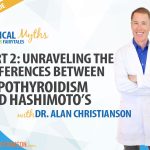T3 Levels: The Risks
The optimal goal of medicine is to help people feel well and to help them thrive. For this reason, we always need to push against things that make us feel great in the moment. If we do not know for sure what they will do to us in the long term.
Your T3 levels are the same way. If you increase your dose, you might feel healthier in the moment, but it might not help you in the long run.
Let’s run through the different levels of T3, and what research has shown levels can mean beyond the immediate results…
Low-T3 Levels
The most important thing to know about below-normal T3 levels, there is an increased risk for cardiovascular disease.1 Essentially, you never want to be below range, as these levels typically lead to disease down the road.
High-Normal T3 Levels
On the high end of normal, we have seen some negative associations with that as well. Here is what the science has to say:
- A risk of non-alcoholic fatty liver disease2
- Higher BMI and more visceral fat, higher blood pressure and fasting glucose3
- High values are associated with high insulin levels and HOMA-IR, and low HDL-C4
Given these risks, we do not want to push somewhere towards a high-normal T3 level. In fact, the idea that someone should have a high T3 level just to feel good and be healthy is really quite dangerous. It can lead to long-term disease risk down the road.
One Large Study
There is one large study I want to call your attention towards. This study tracked a large group of people, and sought to find out which folks had the best response to combination thyroid therapy (meaning T3 and T4).5
In this case, the group of patients on T4-only treatment had persistent symptoms throughout. They reported remaining tired, struggling with weight, and dealing with things like muscle cramps and dry skin. They still remained symptomatic.
After checking all of their levels, the researchers put those studied on a combination of T3 and T3 treatment. A large number, about 70%, saw benefits to these symptoms. They were classified as “responders,” meaning that the symptoms they had on T4-only treatment were improved upon the introduction of combination therapy.
Here is the fascinating part. Comparing responders to nonresponders, there was really no significant difference in T3 levels – or changes down the road.














